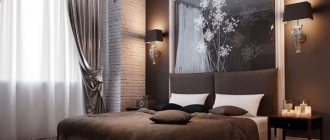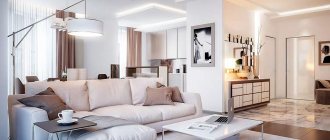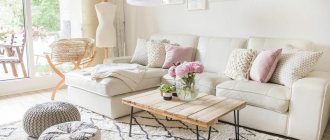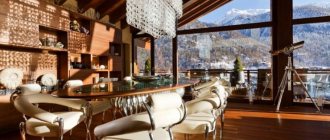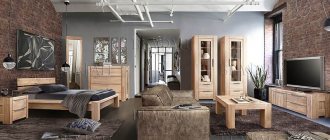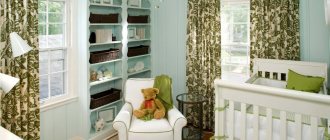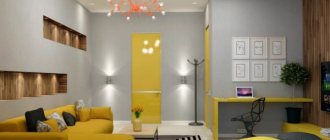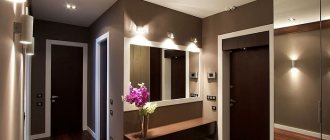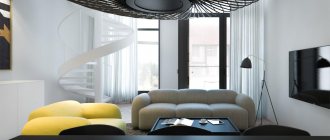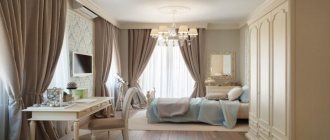Do gray and brown go together? Absolutely yes. Firstly, they both belong to neutral colors (brown is “near-neutral”, along with beige). All neutral shades get along well with each other.
Secondly, the combination of brown and gray is natural. Their shades are intertwined, for example, in the color of stones, mountains, pebbles. No one will argue that the combinations created by Mother Nature are perfect.
Thirdly, brown can serve as a good complement to gray. Gray is cold, stern and serious. Brown is softer, warmer, more comfortable. If, for example, you dilute the gray walls with a brown floor, this will make the room warmer and more comfortable.
However, the gray-brown scheme still remains quite strict and gloomy. Therefore, it is a common choice for industrial-style interiors. The loft imitates the surroundings of industrial facilities, so severity is more than appropriate here. In a loft setting, the combination of gray and brown is usually dark and rough.
However, the interior with this combination can be quite bright and elegant. Taupe schemes are typical for simple Scandinavian interiors and for sophisticated modern classics.
This combination is often chosen for masculine interiors to add an element of brutality to the environment.
When combined with other neutral colors, gray and brown make up the typical palette of modern minimalism. Neutral and conventionally neutral shades are often perceived as absent, invisible, which is quite consistent with the minimalist concept.
Choosing a color scheme depending on the purpose of the room
The selected combinations and density of colors depend on the characteristics of the room - spacious or cramped, high or low ceiling, windows facing north or south. And also on the functional purpose: with what it is customary for a family to combine a living room - with a dining room, with an office, with a guest bedroom.
If the living room is used only for its intended purpose or simultaneously serves as an entrance hall (entrance hall), the preferred color scheme is beige, cream, wood shades. Decorative lamps will enhance the feeling of warmth and comfort and add a few bright touches to the liveliness.
The living room, which is used as a study, can be decorated in English style: muted green and brown tones, furniture with leather upholstery. Likewise, if a home library or bar is located here.
In the living room, which is used as a dining room, “food” colors would be appropriate: caramel, chocolate, coffee. Furniture with the texture of natural wood and cream upholstery is desirable here. For contrasting fragments, it is recommended to choose materials in the yellow-orange range: lemon, orange.
A combination of three colors looks good in the living room: white, brown, beige. With brown it is better to use not a snow-white tone, but “edible” shades: cream, milky. Possible colors for furniture upholstery are apricot or peach. Options for dark inserts - emerald, cherry.
It’s better to have a matte white ceiling: you shouldn’t make it dark in principle, it looks low and overpowering. If there are a lot of thick brown colors in the room, it is not advisable to use a glossy stretch ceiling: it will reflect the interior and look dark. For the same reason, you should not use a ceiling made of mirror panels.
In combination with dark walls, do not install stained glass windows - they have less translucency. It is advisable to laminate window frames (if they are plastic) either monochrome brown or wood-like - the same color as the doors.
Diluting the background
All walls of the room should not be the same shade. It is better to combine light and dark gray, taking into account the location of windows and furniture. Shades of pastel colors, such as cream or peach, also dilute gray walls well.
Large rooms look advantageous in a combination of gray, pearl or graphite colors.
Materials and design
The living room in the spirit of classicism categorically gravitates towards natural and expensive materials: marble and granite, other rocks, valuable types of wood, bronze, copper, gilding, velvet and silk, inlays and precious metals.
Floor finishing
For a classic living room, there is no better choice than graceful and elegant artistic parquet flooring. A touch of antiquity, abrasions, and small defects will give it a special sophistication. Moreover, the living room is one of the few rooms in the house where it is really advisable to use natural parquet.
If you prefer more modern interpretations of style or don't want to sacrifice practicality, choose laminate. Nowadays there are a lot of collections that imitate any other materials, textures and patterns. An even more radical alternative is stone slabs or porcelain stoneware.
Wall decoration
In the living room, feel free to take all those wall coverings that are not suitable in the kitchen or hallway. For example, these are paper or textile wallpapers - a combination of natural textures with ornate patterns
Pay attention to wood paneling, tiled mosaics, or combinations of several different materials at once.
Ceiling design
Popular stretch ceilings are not very appropriate in classic interiors, but complex plasterboard structures are easy to use in different ways. If you still choose PVC film, take a satin or matte fabric. And if the even base of the ceiling allows, it is enough to simply whitewash or paint it.
How to use gray shades correctly
To create the perfect harmonious interior using neutral colors, you need to pay attention to some basic rules.
Brown in the kitchen and dining room
In the kitchen, brown is also very appropriate. It not only gives the room an elegant solidity, but also improves appetite, allowing you to get maximum pleasure from your meal.
In addition, kitchen furniture in rich brown shades is quite practical, since the slightest dirt will not immediately be visible on it. A dark brown palette (chocolate, wenge, coffee) is an excellent solution for spacious rooms. Such shades can make the interior luxurious and truly elegant. For a small kitchen that needs visual expansion, it is worth using lighter shades. The optimal choice would be: beige-brown, caramel, nut and almond colors.
Color characteristics
Brown has always been considered a strong and energetic color. It inspires confidence and is good for relaxation. Brown color is perceived as natural because it is very common in nature. He is the embodiment of reliability and stability. An interior in brown tones relieves stress and helps you escape the endless rush and bustle. This color is chosen by people who are confident in themselves and their abilities, who have found themselves and are firmly on their feet.
Advantages
Decorating a living room in light shades has a lot of advantages:
this technique allows you to visually beat the lack of space, which is especially important in small-sized rooms;
Light colors used to create the interior allow you to create different mixes of the texture of finishing materials. They are not limited in the choice of bright contrasts, they provide a wide range of shades, emphasizing strokes, each time changing the visual perception along with replacing the shade of small furnishing elements, for example, furniture covers, capes, sofa pillows, carpeting, wall lamp decor, painting designs.
Choosing accents for the interior
In fact, it is difficult to imagine a living room in gray tones without eye-catching spots that add personality to the interior. Such a palette with bright accents will be easier to perceive, because such details create the mood, atmosphere, and make the environment more emotional than in a monochrome design.
When choosing bright elements, you should pay attention to harmonious ash shades. Of course, literally all other scales are in harmony with an achromatic color, but not every tone can become an accent, because muted tones will be lost on a fairly intense slate color.
Bright accents in a platinum interior are red, orange, blue, blue, turquoise, pink, purple and, of course, yellow details. They look especially stylish with limited use of laconic and rather original items. Just two or three, maximum four elements can change the character of a composition.
As a bright spot for a living room in steel tones, choose sofa cushions, a rug, a chair or armchair, a wide modern picture frame, a couple of furniture fronts, and curtains.
Interior use
Blue tones eliminate any aggression and quickly relax. Light shades (light cornflower blue, turquoise, azure) visually enlarge the room, so they are suitable even for a small room. Deep tones should be used in the form of accents so as not to unnecessarily darken the room.
Since blue is a cool color, it looks better in sunny rooms with large windows, and apartments that face north may seem gloomy if there is too much of it.
You can use color in any room in the house, it is only important to take into account the designers’ recommendations
Kitchen
The kitchen is a room in which blue can be introduced as a background or filling. The walls are decorated in this color if the room is large enough in size and has a high level of natural light. Combinations of gray, white and blue shades are usually used.
You can also make the decor blue: place a kitchen set in this tone against the background of a white wall, apron, and light curtains. A bright, unusual accent will be a cornflower blue refrigerator or a dining area (chairs with a table), although such furnishings can rarely be found on sale.
Living room
Many tones can be combined with blue, and it is in the living room that there is a chance to conduct more bold experiments. If the windows face south, use a blue-gray combination. A blue and white design will be an excellent option for any room, as it is considered classic and will fill the room with coziness and freshness.
You can use blue in furniture by placing a corner or regular sofa, armchairs, or by using covers on upholstered furniture of this color. Bluish textiles will refresh the interior of the hall: curtains, chair covers, carpet.
Bedroom
The atmosphere of the bedroom will immediately become calm and soothing after the introduction of blue shades. It is better to use this rich color in the form of an accent wall behind the bed or use pale bluish tones in curtains, bedspreads, pillows, and various accessories. A perfect color for a Mediterranean-style bedroom.
Children's
The combination of blue and white in the nursery will also be very successful, because kids like marine themes. To prevent the atmosphere from seeming boring, green, yellow, orange, and red colors are also introduced into the interior as accents. For modest children prone to apathy, bluish shades cannot be used in large quantities, but on the contrary, they will calm a hyperactive child. In teenagers' bedrooms, beige or light brown colors are usually used rather than white.
Bathroom
It is not recommended to decorate the entire bathroom with blue tiles: the room will turn out too gloomy. It is better to decorate the floor, one of the walls in this color, and lay out random ornaments and drawings in tone on the rest. Against a light background, a cornflower blue sink and toilet look original, although it is not easy to find such plumbing fixtures on sale.
There are some features of introducing blue into the bathroom interior:
- If the color is too saturated, always dilute it with warm and pastel tones;
- combine blue with shades of natural wood;
- add elements from other natural materials to the interior, for example, rattan, wicker, marble;
- decorate a small room in blue tones, using rich blue only in the form of accessories;
- use more glossy surfaces - they bring the interior closer to a marine theme.
Hallway
Dark colors are only suitable for well-lit, open rooms. As a rule, there are no sources of natural light in the corridor, so the wallpaper here can be made sky blue, azure, light cornflower blue, not darker. A cabinet made of light wood and other wooden decorative elements will look beautiful.
Types of structures
When choosing a design, it is important to take into account many nuances: find out the dimensions of the room, determine for what purpose you need a sofa. Depending on the purpose, there are two main types of structures:
- Modular. This type is good because you can choose the elements that will make up the sofa, its size and the number of seats. During use, you can change the shape of the structure as you wish, moving and combining individual elements with each other.
- Folding. This type is more compact, but no less practical. There are several types of folding structures, they are transformed in different ways. If necessary, the folding design will easily provide you with an additional sleeping place.
Both designs can be either straight or angular.
Finishing ceilings, walls and floors
The decoration of walls, floors and ceilings does not depend much on the main palette, but here some nuances must be observed, especially if the design includes a gradient or another transition of shades.
For the floor, it is best to choose linoleum, ceramic tiles, or make it self-leveling. These materials are easy to clean, resistant to wear and tear, and retain their decorative appearance for a long time. Laminate is susceptible to water damage, although its surface is less contaminated than traditional wood planks or parquet. Traditional materials have a limited selection of shades, unlike modern ones, where the choice is very extensive.
The first place among finishing materials for walls is traditionally occupied by wallpaper, despite its short service life and the fact that it is easy to get dirty. Painting is considered the most practical, since painted walls can be easily washed when the need arises, and a modern living room made in white or any light colors will often require cleaning.
Stretch ceilings designed in light colors are an excellent solution for modern decoration of a living room in a modern style. They are very functional and are successfully used on uneven surfaces. Ceiling coverings of this type stretch very quickly, and the stretch ceilings themselves can have a glossy or matte surface, with or without a pattern.
Features of a living room in beige color
Beige color has many shades: light beige, creamy beige, peach, nut, cocoa color and many others. Each of these shades is widely used when decorating living rooms and is very popular among professional designers. Beige shades have deservedly become design classics, because it has been proven that they have a beneficial effect on the human psyche, calming his nervous system. Decorating a living room in beige has a number of advantages:
- Ease of combining this color with other shades.
- Using light shades you can visually increase the area of the room.
- This color never goes out of fashion, maintaining its relevance throughout the centuries.
- Shades of beige fit into any interior style; they are universal, but at the same time help to give the living room a zest.
- These colors look advantageous both in daylight and in artificial light.
More effectively, beige shades in the living room will be combined with colors such as brown, purple, black, green, red and gray. But the absolute classic is beige combined with brown.
What styles can a beige living room be designed in?
Due to its versatility, beige color will be appropriate in the following areas:
Classic
Here it is important to remember symmetry, conciseness and severity of lines. When choosing beige wallpaper, make the floor dark
This rule also applies to furniture; beige upholstery is best framed in dark colors. Classics do not accept diversity; choose the basic shades that will be used in decoration. Country. This style, like no other, gravitates towards naturalness. What if the color beige does not represent the natural, the natural and the natural. In a country living room, this color serves not just as a background, but it is also actively used in accessories, furniture, and textiles. It can only be diluted with brown shades, but in no case with pink, purple or red. Natural stones and dried flowers can be used as accents that will enliven the interior.
Minimalism. Beige color combined with minimalism is an ideal solution for small living rooms. A minimum of functional furniture in light shades will visually expand the room, and a few bright accents can add a certain zest to the design. Modern. A beige living room in Art Nouveau style will become a real work of art if you carefully think through the accents. Textiles, an unusual carpet or vases can become spectacular spots in a calm interior. Colors should complement each other, but it is important to achieve balance and “crush” one color with another. High tech. Despite the fact that sometimes rich colors predominate in this style: blue, red, black, white, most often preference is given to beige shades in combination with gray. It is this ensemble that is able to focus on ultra-fashionable design with modern technology. This style involves the use of glass, metal, and mirror elements, which, in combination with beige color, will make the room stylish and exclusive.
From monochrome to avant-garde
If you look at the photo of a living room in a classic style, you will notice that not only the walls, ceilings and floors are made in beige tones, but also the furniture
However, if you pay attention, all items are presented in different colors. Furniture is slightly darker than walls and ceilings
And paintings and other tabletop items have dark brown and yellow frames. This style is called monochrome and involves a combination of smooth glossy and matte surfaces with convex or rough materials. This can be wallpaper with fragments of silk-screen printing on a relief background, or patterned convex furniture upholstery. The wood pattern of the flooring, the roughness of the plastered ceilings, the smoothness of the marble surfaces of the fireplace - all of this serves as a decoration for the room. Even a non-professional can complete such a simple design.
The sandy ceiling and wallpaper on the walls will come to life with floor vases and sofa cushions in bright oranges and bold yellows. With them, any room will seem warmer and more comfortable. And if you are a lover of coolness and seascapes, then the interior of the living room in beige tones can be enlivened by blue and blue additions in the form of accessories, glassware or paintings. The greenery of indoor plants will enliven a seasoned style and add a little freshness. Don’t be afraid to add other colors because of the uniqueness and conservatism of the beige tone.
All shades of red, lilac and purple can give the room a festive look. For example: lilac armchairs and a purple sofa will add a bright note to the monotonous and calm look of your room in a classic style. To visualize such a bold idea, we have placed below a photo with colorful furniture. Anyone who loves avant-garde style and originality can enjoy the designers’ ideas and turn them into reality on their own territory. It cannot be said that light furniture is suitable for a married couple with children. It is bright and dark furniture that will hide small stains that are inevitable in the presence of children and pets. The main thing is not to overdo it with colors so that the main beige background prevails. And the bright additions were not numerous.
Reasons for popularity and color features
Brown sofas are very popular not only when decorating the interior of a living space, but also in offices and study spaces. The furniture has the following advantages:
- good compatibility with most styles;
- a large number of varieties, designs;
- brown furniture is produced by almost all well-known companies;
- external respectability (especially for leather models);
- creating a cozy, warm atmosphere;
- color is used in budget and luxury models;
- looks natural.
Brown color has a calming effect. There is a rich palette of shades from light brown to dark chocolate. Depending on the interior design style, sofas in the following colors are used:
- Beige-brown. It is versatile, very delicate and visually increases the space of the room.
- Taupe. Suitable for any style solution.
- Dark brown. It has strict lines and a discreet design, so it is perfect for decorating an office.
- With a reddish tint. Such furniture has an unusual appearance, so it can become the main element of the interior.
Dark brown
Beige-brown
With a touch of red
Taupe
Popular interior styles
The colors of concrete, asphalt and iron are most often used in modern interiors, but classic motifs are not alien to them.
Loft
The industrial style of the urban jungle consists almost entirely of gray concrete blocks, metal structures and chrome ventilation systems. A gray interior in this style will be complemented by wide panoramic windows.
Credit: @
In a loft there is no place without metal and brick.
Industrial concrete finish in grunge style.
High tech
Steel shine, polished plastic, tempered glass and the latest technology – these are the pillars on which high-tech is based and where the gray palette looks as organic as possible.
Credit: @
Graphite high-tech kitchen.
Credit: @
Light walls in a high-tech kitchen.
Adviсe
Some useful points that will help you choose the best combination of colors in the living room interior:
- Don't be afraid to use bright colors. Let's say you have furnished your living room in a classic design, using brown, noble beige and a little green. And everything is beautiful and dignified, but something is missing, there is a feeling of a slightly boring space. So spice up this color selection by adding unexpected pops of orange or pink. Turquoise, warm yellow and other bright contrasting shades may be suitable. Decorative pillows, wall panels, sofa upholstery and other decorative items can be made in this accent color. And you will see how the walls and furniture in the living room will sparkle, the interior will become warmer and more interesting.
- Deep blue color goes well with berry tones. Why not try decorating the walls and furniture of the living room in a blue and burgundy version with an accent, for example, in a dark green version. Only the colors should be muted, warm, natural shades, and not neon or acidic. A living room in a similar design takes on a luxurious look: the color of the walls, the upholstery of the sofa, the shade of the curtains - everything will look harmonious. At the same time, such a selection will delight with its thoughtfulness and decorativeness.
- If the living room has a strict black and white design, then you can decorate its walls with bright colors of red or yellow, or add a little green. You will see how much the interior will change after this; the living room will immediately take on a lively, warm look.
- It is better to choose warm and soft colors for wall decoration, curtain colors and sofa upholstery rather than cold ones. A living room decorated in warm colors always looks more cozy and comfortable. Beige and orange are always visually more comfortable than lilac or cool blue.
- You can try this rather bold option: paint the entire living room in light mint-sand shades. And as a contrasting tone, add dark beige, turquoise or add bright green. Such a living room will be a real source of pride for the owners and an ideal place for relaxation and meeting with friends.
- Don’t use too many details in a contrasting color - one large or two or three small ones will be enough to highlight the main decoration of the room. For example, in a grayish-beige living room, one bright red large sofa or several small pillows and a painting on the wall in a contrasting color will look great.
- The more natural the basic colors of the floor and walls, the more daring experiments with contrasting shades of curtains and sofa you can afford.
Whatever color combination you choose, do not forget to adhere to the rule of proportionality between contrasting and primary colors - and, without a doubt, even your own living room design will look great.
https://youtube.com/watch?v=_MezU8D04Uc
https://youtube.com/watch?v=3ZmwjO9eO_Y
Successful combinations
Walls, furniture, curtains should not be chosen in gray tones. You will need a spot of color that will enliven the interior of the room. If gray is the main one, then you can choose others in contrast. But you shouldn’t take more than 3 tones.
With white
The combination of white and gray in the bedroom is ideal as it has a relaxing effect. In a small room, more white is needed, and saturated shades are chosen from gray shades. Geometric patterns and abstractions on walls and pieces of furniture will look interesting. The emphasis on the white bed distracts from the fussy base tone. Snow-white tulle curtains and a light carpet will complement the bedroom design. You can contrast white walls with furniture in gray tones. A bed with a textile headboard will provide special warmth, and a small rug will complement it.
With pink
The severity of gray in the bedroom can be softened with pink. Pearly colors are ideal next to powdery tones. Fuchsia accents liven up the light gray walls. Here you should not overdo it with pink, otherwise sophistication will turn into excessive naivety. It is enough to include 30% of the tone of a girlish blush.
With blue
Playing with the color blue will help refresh your bedroom. Even one contrasting spot, like a blue vase, can bring out the shades of gray and ash in the room. The price of neutral furnishings will increase if you combine adjacent tones of blue and grayish.
With yellow
The color of stone and concrete makes the bedroom gloomy. And golden yellow will add light. But do not overdo it with yellow trim, otherwise the harmony of the interior will be disrupted. It is better to accentuate the textiles of the room with yellow. You can choose gray-yellow prints on walls, carpets, paintings.
With brown
Gray can be partnered with all shades of brown in the bedroom. Dark or light, they will delimit the zones of the room. If the bed is in a romantic haze, then the linen closets are made of natural dark wood. A dry interior will become warm when combined with a brownish floor. Rug patterns and picture frames will also make your bedroom feel cozy.
With blue
The gray-blue palette of the bedroom will add vigor in the morning. A cold combination is especially recommended in rooms facing southeast or south. Neutral colors relax you after an active day at work. In such an environment they relax emotionally.
White
One of the best color combinations is combining gray with white. This classic solution is suitable for styles such as modern, minimalism, art deco. White can be used as a pure color or in various variations, such as cream or cream. A modern gray living room combined with white creates a win-win design option.
Successful combinations with other colors
Designers use brown tones so that they do not create a gloomy mood. Compositions with other shades are needed to create color unity in the living room.
With green
The tones of wood and foliage look organic together. In a brown living room, the colors of swamp, moss, and pistachios are appropriate. Emerald and malachite shades are used in classic interiors. Green tones give the room more freshness. You can place indoor plants on shelves and window sills in the living room. Textiles in greenish tones are used: pillows, blankets.
With blue
Rich brown colors in the room are successfully combined with sky blue. It is best if the walls are painted turquoise, ultramarine or azure. Then the flooring and furniture choose the colors of tree bark. The beige walls are in harmony with the pure blue plastic on the furniture.
With yellow
Brown shades are close to yellow and golden tones. Rich tones of yellow are used in the selection of textiles and accessories. In the chocolate living room, golden silk curtains are hung on the windows. You can experiment with the ceiling by painting it in the colors of the sun. Then there will be more space.
With gray
The combination of gray and brown is ideal for Scandinavian style. The background for the living room is white. Upholstered furniture made of natural wood can be covered with shaggy gray wool blankets or fluffy pillows. The coldness of gray is lost in the warmth of brown, giving the room a cozy feel.
Coffee with milk
Coffee color is chosen as the predominant color in the design of the living room. It harmonizes with the sandy tones of textiles and the richness of brown in furniture made of natural wood.
The interior becomes luxurious if you use chocolate-colored trim and light coffee-colored furniture. Appropriate textiles and lamps are selected for it. It is best to make the wall behind the back of the sofa a single color by choosing either a dark or light shade of wallpaper or panels. The pattern on the textiles should match the color of the wall decoration.
Gray furniture and decor
Slate and smoky colors are a practical and universal option for any interior items. Let's take a closer look at what color of wallpaper suits gray furniture best and what it will make a good pair with.
Stylish monochrome interior with walls and furniture in graphite tones
Cushioned furniture
A sofa in graphite or asphalt color is the most popular option for decorating a living room: this practical shade makes it easier to care for upholstered furniture. In addition, these tones are in harmony with all colors, which makes choosing pillows easier - you can easily change the design of your living room by simply changing decorative pillowcases. The most versatile will be models with fabric upholstery with a smooth texture. The background for such a sofa can be either neutral white and beige walls, or more expressive ones - for example, dark blue, emerald green, yellow and burgundy.
A laconic light gray sofa does not distract attention from the accent blue wall
A graphite gray sofa is an invariable attribute of a Scandinavian interior with white walls
A light gray sofa with fabric upholstery is a universal solution for any interior
Despite the basic shade, sofas made of leather or velvet will become the main accent of the entire room, even if you used gray paint or wallpaper in the interior of your room, as in the photo below.
Thanks to the velvet texture of the upholstery, the noble graphite shade of the sofa is revealed
An armchair, pouf or ottoman can be in the same dark color scheme, or lighter (for example, pearl) - usually they are not used as intensively as a sofa, so this solution will still be quite practical. Small pieces of upholstered furniture in these colors will help balance the bright design of the living room or bedroom, balancing the riot of colors on the walls and textiles.
Minimalist gray armchairs help balance out the vibrant interior of this living room.
A gray pouf that matches the color of the walls does not distract from the main accent of this room - a bright blue sofa
An ottoman in a calm light gray color harmonizes the bright color of the walls and the original upholstery of the furniture
Furniture for kitchen
A steel-colored kitchen is an absolutely universal solution for any style. For classic or Provence, choose a set with paneled facades, complementing it with a countertop made of natural stone or its imitation. In laconic modern styles, smooth, plain cabinets with hidden handles and a wooden tabletop (including painted) look better. Matte facades are more versatile, but glossy ones will help visually enlarge the space and make it lighter.
Kitchen in gray tones in Scandinavian style complemented by wooden details
A gray kitchen with paneled fronts and brass details is an excellent choice for the neoclassical style
A light gray set with smooth fronts is a universal option for a kitchen of any size
Gray chairs - classic dining or bar stools - are the best solution for Scandinavian-style kitchens, especially if you choose models with upholstery. They harmonize perfectly with natural wood furniture (for example, a dining table) and support the overall aesthetics of the “northern” style.
Dark gray chairs in the interior of a Scandinavian-style kitchen-dining room
Graphite gray chairs go well with natural wood furniture in the kitchen
Light gray bar stools support the laconic interior of this small kitchen
Storage furniture
Cabinets in smoky tones are a good solution for built-in storage systems: they allow you to hide bulky structures in the interior as much as possible and divert attention from them. The best answer to the question of what cabinet colors go with gray wallpaper or paint in a small room is a shade close to it.
The gray cabinets in this interior blend into the walls and make the room feel lighter and more spacious.
A light gray cabinet that spans the entire height of the room does not look bulky in a small room
Graphite cabinets match the shade of the walls and visually dissolve in space
As for small pieces of furniture for storage (pedestals, chests of drawers), they are perfect for a bedroom or nursery: bright models can distract and interfere with a comfortable sleep, while neutral gray ones will not be noticeable. They will perfectly complement a room in white, beige, blue or powder pink.
A gray chest of drawers is a great alternative to a bulky closet in a small bedroom
A light gray chest of drawers complements the interior of this nursery in soothing colors
The gray-blue bedside table matches the color of the textiles in this bedroom
